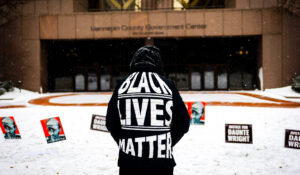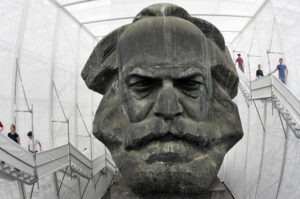There is something presumptuous lurking in the very phrase, “the Left”. Under a show of cosmopolitan inclusion, the term hides a reality of unconscious parochialism. The parochialism is both geographical and historical in nature.
First there is the implicit geographical parochialism. In response to the invocation of the notion of “the Left”, one might reasonably ask: the Left where? Do we mean the Left in Hungary, or China, or Russia, or Iran, or Afghanistan, or India? Might the Left in some places not be different from the Left in others? If so, this would give us many Lefts, not the Left. For example, some Lefts might be libertarian in nature, not least where forms of social authoritarianism reign. In such places, a system of rights and free markets might look like liberation. Yet for some, such a position can only count as being on “the Right”.
This suggests that there is a circumstantial relativity to the very idea of Left and Right. Devotees on both sides dislike this fact. They usually deny it. For them, there is some essential content residing in the concept of the Left. They contend that it is an ideology with roots. Therefore, they believe, it constitutes a tradition. But when did this supposed tradition begin? We know the spatial metaphor derives from the period of the Legislative Assembly in Revolutionary France. Looking back, actually both sides (Left and Right) had merit. Consequently, neither position need awaken dogmatic partisanship. Equally, modern political attitudes can hardly be divided in terms of this antiquated polarity.
Was Friedrich Hayek on the Right? I personally don’t think this characterisation makes much sense, even if recent activist historians insist on connecting his ideas to an ill-defined “neo-liberal” resurgence. Hayek, as an Austrian, was a critic of German nationalism in both its economic and political manifestations. For good or ill, he came to regard Stalinism and National Socialism as extreme expressions of the same basic worldview. He called himself a Liberal, never a Conservative, and for those in the Eighties opposed to Hungary’s or Czechoslovakia’s communist leaders, he might plausibly have been identified as Left.
These clarifications are not offered as a defence of any form of Hayekian dogma, but they are meant to imply that there is a need to correct prevailing misrepresentations. From the point of view of scholarship, it makes no sense characterising Hayek relative to our own concerns. Times change, and the meaning of political affiliations changes with them. Equally, at any given moment, party loyalty can cover a great variety of positions. Was Winston Churchill on the Right in the sense that Margaret Thatcher was? How close was Boris Johnson ideologically to the very ideological Liz Truss?
Was Oliver Cromwell on the Left? Or was Thomas Paine? Was George Orwell? I think it depends on whom you ask. Was Mahatma Gandhi Left? Is Xi Jinping? Was Stalin, or Erich Honecker? Some may think that all these figures could be grouped by family resemblance. Others might repartition these Lefts into a new Left and Right. Still others would insist they make up a venerable tradition. But this, surely, could not be squared with historical fact. Instead of a tradition, this Left would be an invented tradition.
Dispassionate commentators do not need the crutch of Left and Right. Their job is to study and describe processes impartially. For example, at least in principle, academics are not required to locate themselves, or their subject-matter, along some imaginary spectrum. One would hope the same would apply to journalists. On the other hand, politicians are openly obliged to display their colours. They need to appeal to partisan sensibilities by compartmentalising positions into good and bad.
Strangely, despite their hard-won independence and their enjoyment of intellectual freedom, academics are often moved to mimic the attitudes of politicians. This is perhaps especially the case in more recent years. Over the last century, the politicisation of the academy has come and gone in waves. Over the past decade, signalling ideological preferences has become a sort of fashion. As a result, it is astonishing, but true, that most lecturers are afraid of saying something that their peers might arbitrarily identify as “Right” wing. By “Right”, they mean wrong. They mean it’s morally bad, at least in the eyes of the dominant peer group.
I say this is astonishing because historical investigation commonly shows that political choices are not simple. They never present a straightforward good opposed to an unambiguous bad. Academic historians and philosophers should know this: circumstances are usually ambivalent and consequences uncertain. Naturally party politics is impelled to streamline and moralise the alternatives. However, academic evaluation need not do this. It does not have to resign itself to party-political categorisations.
The most important elections we face are national elections. During the hustings, the prevailing political configuration will likely be compared with the state of affairs elsewhere. But the national scene won’t so much be juxtaposed with Ethiopia or Azerbaijan as it will with Europe and the United States. This shows that when we ask where the Left is today, we are asking a local rather than a world-historical question. In Britain, “the Left today” largely refers to something altogether smaller than Nato. Roughly, it encompasses affinities between French, German, British and American politics. To repeat, then: our understanding is historically and geographically parochial despite claims that the Left embraces a cosmopolitan worldview.
While the Left, like any other set of political attitudes, is parochial, its commitments are inevitably partisan. Although the rhetoric is outwardly universalist, the orientation is nearly always sectarian. In fact, the determination to capture and purify the Left is a symptom of this narrow partisanship. On average, Left particularism assumes that virtue resides in just half of the population. This refers to that portion which votes in the preferred way. In certain constituencies, for example in universities, that cohort shrinks to less than 20%: only this faction is “truly” Left. Since this proportion can never constitute a real electoral force, it must make up for its lack of power with the intensity of its beliefs.
But while the Left in the educational sector lacks immediate political power, it enjoys significant influence. Members of the teaching profession, the publishing and heritage industries as well as the print and broadcast media are products of a broadly conceived university culture.
Since the Eighties, if not earlier, generations have been inducted into a diffuse postmodern ideology commonly denominated “identity politics”. The resulting fetishisation of the rights of personhood is often accompanied by confected outrage. It registers an obsession with negligible degrees of marginalisation and tends to abominate just mildly unfavourable attitudes. The assumption is that no one should feel “offended” or “uncomfortable”. What was once disliked as an opposing view is now abhorred as a kind of evil. Disadvantage is mostly conceived within the bounds of middle-class privilege. Consequently, the approach tends to verge on narcissism. The main casualty in all this is a sense of proportion and coherent social policy.
Where, then, is the Left today? It is not fighting an age-old struggle or advancing the cause of international fraternity. It is waging a provincial campaign in a struggle with forces slightly further to the Left and with various opponents on the Right, all deriving their meaning from the fairly recent past. This Left is operating after the demise of socialist planning of the soft and hard varieties. The soft kind fell at least partly at the behest of the electorate at the end of the Seventies after a postwar period of high expenditure failed to alleviate social dissatisfaction or deliver in terms of growth or mobility. The hard kind fell in 1991 with the collapse of Soviet power. An era of Left disorientation has followed.
As I’ve been suggesting, this disorientation has a cultural and a political axis. The cultural side is concentrated in sectors that influence opinion. It is preoccupied with “inequities” in race and gender. Its focus often lacks demographic specificity — which “races”, we are left asking, and gender in which class? What is championed is a rudimentary egalitarian programme constructed around the concept of “balance”. Its focus is on comparative advantage in the professions and symbolic capital in society at large.
The cultural agenda is poorly integrated with the other hinge of the Left, the party-political wing. This side for the most part is concerned with public sector funding, which is basically a matter of fiscal policy. To the extent that the two flanks overlap, they align on the issue of mobility, without necessarily agreeing on what mobility is intended to achieve. The cultural sector is without clear questions while politicians lack definite solutions. In the end, just one thing is plain: neither the cult of victimhood nor the obsession with the “microphysics” of power will be of any help. As the Labour Party tentatively prepares for government, it stands in need of a fundamental rethink.
Disclaimer
Some of the posts we share are controversial and we do not necessarily agree with them in the whole extend. Sometimes we agree with the content or part of it but we do not agree with the narration or language. Nevertheless we find them somehow interesting, valuable and/or informative or we share them, because we strongly believe in freedom of speech, free press and journalism. We strongly encourage you to have a critical approach to all the content, do your own research and analysis to build your own opinion.
We would be glad to have your feedback.
Source: UnHerd Read the original article here: https://unherd.com/



